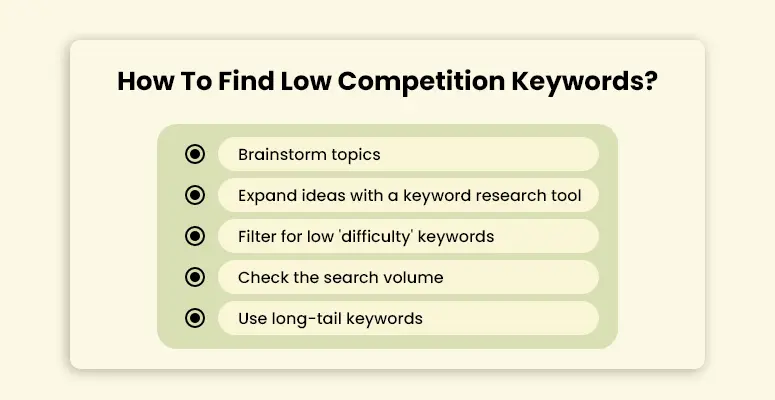
Are you tired of putting in countless hours creating great content for your blog, only to have it buried deep in search engine results pages?
It can be frustrating to see your hard work go unnoticed. But fear not, there is a solution: targeting low competition keywords for blog.
Low competition keywords are the hidden gems that can help you rank higher in search engine results pages and drive more traffic to your website.
Let’s dive into the world of low competition keywords with high traffic, including what they are, how to find them, and how to incorporate them into your blog strategy.
Understanding Low Competition Keywords
Low competition keywords have relatively low competition among websites targeting them. These keywords are often less popular and less frequently searched but can still attract a significant amount of targeted traffic to your website.
When it comes to keyword research, many bloggers and website owners focus on high volume, high competition keywords, assuming that the more popular a keyword is, the more traffic it will bring.
However, this approach often fails to take into account the competition for those keywords, which can be incredibly difficult to rank for.
This is where low competition keywords come in.
By targeting less competitive keywords, you increase your chances of ranking higher in search engine results pages (SERPs) for those keywords, implying your website is more likely to be seen by people, specifically searching for the content you offer.
While low competition keywords may not have as high search volumes as high competition keywords, they can still drive desired traffic to your website.
In fact, targeting a variety of low competition long tail keywords can often be more effective than focusing solely on high volume keywords, as it allows you to cast a wider net and attract a more diverse audience.
Moreover, low competition keywords with high traffic often represent specific niches or long-tail keywords, which can be incredibly valuable for businesses targeting a specific audience or looking to rank for product or service offerings.
By targeting these types of keywords, businesses can reach the people most likely to be interested in their offerings and improve the overall quality of their traffic.Low competition keywords can be a valuable addition to any website’s keyword strategy.
By targeting these keywords, you can increase your chances of ranking higher in search engine results pages, drive targeted traffic to your website, and improve the overall quality of that traffic.
How To Find Low Competition Keywords?
There are several ways to find low competition keywords for your website, including brainstorming, using keyword research tools, and filtering for low competition keywords with high traffic.

Here are some techniques to consider:
Brainstorm Topics:
Start by brainstorming topics related to your niche or industry. Think about the questions your target audience might be asking and the types of content they are likely to be interested in.
For example, if you run a fitness blog, some potential topics might include “healthy meal prep ideas,” “best at-home workouts,” or “how to stay motivated to exercise.”
Or let’s say you run a travel blog and you’re brainstorming potential topics.
Some ideas might include “best beaches in Europe,” “safest countries to travel solo,” and “budget-friendly destinations in Asia.
Expand Ideas With a Keyword Research Tool:
Once you have a list of potential topics, use a keyword research tool to expand your ideas and identify relevant keywords.
One great tool to consider is Serpple, which allows you to search for keywords by their search volume, competition, and other factors.
For example, if you search for “healthy meal prep ideas” in Serpple, you might find related keywords like “easy meal prep recipes,” “healthy meal prep for weight loss,” and “meal prep containers.”
Using Serpple, you can enter each of these topics as a keyword and get a list of related keywords. For example, if you search for “best beaches in Europe,” Serpple will suggest related keywords like “best beaches in Greece,” “best beaches in Spain,” and “best beaches in Croatia.”
Serpple also provides search volume data for each keyword, making it easy to identify keywords with both low competition and high search volume.
Learn how to track keyword rankings in 3 steps.
Filter for Low ‘Difficulty’ Keywords:
After generating a list of potential keywords, filter for low difficulty keywords. This is where you’ll find keywords with low competition which has high traffic will help you rank higher in search engine results pages.
Here, Serpple provides a difficulty score for each keyword based on its competition and other factors. Aim for keywords with a difficulty score of 30 or below for the best chance of ranking higher in SERPs.
For example, if you search for “best beaches in Croatia” in Serpple, you might find a keyword like “best hidden beaches in Croatia” with a difficulty score of 28.
This keyword is likely to have less competition than broader keywords like “best beaches in Croatia,” making it easier to rank for.
Check the Search Volume:
While you’re looking for low competition keywords for blog, one should also consider the search volume. Aim for keywords with a search volume of at least 100 per month to ensure your content will attract a meaningful amount of traffic.
For example, if you search for “budget-friendly destinations in Asia” in Serpple, you might find a keyword like “budget-friendly places to visit in Southeast Asia” with a search volume of 390 per month.
This keyword has a relatively low search volume, but it’s also highly targeted and likely to attract visitors specifically interested in budget-friendly travel in Southeast Asia.
Use Long-tail Keywords:
Long-tail keywords are phrases that are more specific and targeted than broader keywords. They typically have lower search volumes but also lower competition.
For example, instead of targeting the broad keyword “fitness tips,” you might target the long-tail keyword “best at-home workout for abs.”
Serpple can help you identify relevant long-tail keywords for your content, which can be a great way to attract targeted traffic to your website.
Is Finding Low Competition Keywords Really This Simple?
Yes and no.
While finding low competition keywords is fairly straightforward, it does require some effort and a bit of research. You’ll need to put in the time to brainstorm ideas, do keyword research, and analyze your competition.
However, the truth is that with the right approach and tools, it’s much easier than you might think.
According to a survey by Ahrefs, a popular SEO tool, over 90% of all web pages get no traffic from Google. This is because these pages are targeting highly competitive keywords that are difficult to rank for.
By contrast, targeting low competition keywords for blog can help you stand out in search results and attract more traffic to your website.
Another study by Moz found that long-tail keywords (which are often lower competition) account for more than 70% of all searches.
This means that there is a vast pool of low competition keywords available for those who are willing to do the research and put in the effort to optimize their content accordingly.
Of course, to find low competition long tail keywords, isn’t always simple.
It requires careful research and analysis to identify keywords with the right combination of low competition and high search volume. However, there are plenty of tools available to help streamline the process, such as Serpple.
In addition, this tool offers advanced features like keyword difficulty scores, which can help you quickly identify low competition keywords.
For example, a keyword with a difficulty score of 10 is likely to be much easier to rank for than a keyword with a score of 90.
Serpple, as a powerful keyword research tool, can help you find low competition keywords quickly and easily by offering a wide range of features to help you optimize your content for search engines and attract more traffic to your website.
Serpple generates keyword ideas based on your initial search terms that can be incredibly helpful when brainstorming topics and finding related keywords to target.
Additionally, Serpple offers advanced filtering options to help you quickly identify low competition keywords with high search volume.
In addition, Serpple offers a variety of other features to help you optimize your content for search engines, including the ability to analyze your competition and track your keyword rankings over time.
This can be incredibly helpful when assessing the effectiveness of your SEO strategy and making adjustments as needed. So while finding low competition keywords does require some effort, it’s certainly not an insurmountable task.
With the right tools and a bit of persistence, you can identify keywords that will help your content stand out in search results and attract more traffic to your website.

Balancing Search Volume and Competition
When it comes to keyword research, one of the most important factors to consider is search volume. Search volume refers to the number of searches that a particular keyword or phrase receives on a monthly basis.
While high search volume keywords can be incredibly lucrative, they tend to be much more competitive. Conversely, low search volume keywords often have less competition but may not attract as much traffic to your website.
For example, let’s say you run a fitness blog and are looking to target keywords related to weight loss.
The keyword “weight loss tips” might have a high search volume, with thousands of people searching for it every month.
However, this keyword is also highly competitive, with many other websites targeting it as well. This means that it may be difficult to rank highly for this keyword and attract organic traffic to your website.
On the other hand, a keyword like “weight loss tips for beginners” may have a lower search volume, with only a few hundred searches per month.
However, this keyword is also much less competitive, with fewer other websites targeting it. It may be easier to rank highly for this keyword and attract organic traffic to your website.
Ultimately, the best approach to keyword research is to strike a balance between search volume and competition.
While high search volume keywords can be incredibly lucrative, they often require a lot of effort and resources to rank for.
On the other hand, targeting low search v
olume keywords can be a more efficient use of your time and resources but may not attract as much traffic to your website.
One strategy is to focus on a mix of high and low search volume keywords, with an emphasis on targeting long-tail keywords. Long-tail keywords are longer, more specific phrases that often have lower search volume but are also less competitive.
By targeting a mix of high and low search volume as well as long-tail keywords, you can maximize your chances of attracting organic traffic to your website while also avoiding overly competitive keywords.
High Search Volume vs. Low Search Volume: Pros and Cons of Keyword Targeting
Let’s take a closer look at the differences between the two:
High Search Volume Keywords:
Pros:
- High search volume keywords have the potential to attract a large amount of traffic to your website if you are able to rank highly for them.
- These keywords are often more general, which means they have a wider audience and potential customer base.
Cons:
- High search volume keywords are often much more competitive, which means it can be difficult to rank highly for them.
- Because these keywords are more general, they may not be as targeted as low search volume keywords.
Low Search Volume Keywords:
Pros:
- Low search volume keywords are often less competitive, which means it may be easier to rank highly for them.
- These keywords are often more specific and targeted, which means they have a higher chance of attracting interested and engaged visitors to your website.
Cons:
- Low search volume keywords may not attract as much traffic to your website as high search volume keywords.
- Because these keywords are more specific, they may have a smaller potential customer base.
Ultimately, the best approach to keyword targeting is to strike a balance between high and low search volume keywords.
By targeting a mix of high and low search volume keywords, you can maximize your chances of attracting organic traffic to your website while also avoiding overly competitive keywords.
Additionally, it’s important to focus on long-tail keywords, which are longer, more specific phrases that often have lower search volume but are also less competitive.
By targeting long-tail keywords, you can attract more targeted traffic to your website and increase your chances of converting visitors into customers.
Low Competition Keywords and High Traffic: How Are They Related
Think of low competition keywords with high traffic like a hidden gem. While high competition keywords may seem like the shiny, valuable jewels everyone is trying to grab, low competition keywords with high traffic are like hidden gems waiting to be discovered.
By taking the time to find these hidden gems, you can uncover a wealth of untapped potential for your website’s SEO strategy.
These keywords may not have the same glitz and glamour as high competition keywords, but they can be just as valuable (if not more so) for attracting a relevant audience to your website and improving your search engine rankings.
In a way, it’s like finding the perfect fishing spot that’s not crowded with other fishermen.
While everyone else is fighting for a spot on the crowded riverbank, you’ve found a quiet spot where the fish are biting and there’s plenty to catch.
So, if you want to improve your website’s SEO and attract more organic traffic, don’t just focus on the high competition keywords.
Take the time to explore the hidden gems of low competition keywords with high traffic and discover the untapped potential waiting for you.
Benefits of Targeting Low Competition Keywords with High Traffic
- Attract more organic traffic: By targeting low competition keywords with high traffic, you can attract a large amount of organic traffic to your website without having to compete against more established websites and businesses.
- Increase your chances of ranking well in search results: Low competition keywords are often easier to rank for than more competitive keywords, which means you have a higher chance of ranking well in search results.
- Improve your website’s SEO: Targeting low competition keywords with high traffic can improve your website’s overall SEO and increase your chances of ranking well in search results for other keywords as well.
In conclusion, finding low competition keywords with high traffic can be a highly effective strategy for improving your website’s SEO and attracting more organic traffic.
Finding Low Competition Long Tail Keywords
Finding low competition long-tail keywords is a great way to attract a more targeted audience to your website and improve your SEO.
Long-tail keywords are longer and more specific phrases that are less competitive than shorter, more general keywords.
You can attract a more specific audience to your website who are more likely to convert into customers or clients.
Here are some tips for finding low competition long-tail keywords:
- Analyze your competitors: Analyzing your competitors’ websites and content can give you insights into the keywords they are targeting and help you identify long-tail keywords that they may have missed.
- Use Google Autocomplete: When you start typing a search query into Google, it will suggest related long-tail keywords in the autocomplete dropdown menu. This can be a great way to identify long-tail keywords that are relevant to your niche and have low competition.
- Use Google Search Console: Google Search Console can give you insights into the search terms that people are using to find your website. This can help you identify long-tail keywords that are already driving traffic to your site and optimize your content to target those keywords more effectively.
By targeting low competition long-tail keywords, you can attract a more specific and targeted audience to your website, improve your SEO, and ultimately drive more conversions and sales.
So, take the time to research and identify these keywords and optimize your content to target them effectively.

The Bottom Line
Finding low competition keywords can be a powerful tool for improving your website’s SEO and driving more organic traffic.
By using keyword research tools, analyzing your competitors, and targeting long-tail keywords, you can attract a more specific and targeted audience to your website.
Remember that the process of finding low competition keywords for blog may require some effort and research, but it can be well worth the investment in the long run.
As you continue to optimize your content for these keywords, you can improve your search engine rankings and attract more conversions and sales.
So, take the time to research and identify these valuable keywords and use them to unlock the untapped potential of your website’s SEO.
With patience, persistence, and a willingness to experiment, you can take your website to new heights and achieve your business goals.
Divanshu
Posted on March 30, 2023
Divanshu is an engineer turned marketer. As SEO Manager, he is responsible for implementing strategies that help Scrapingdog to increase brand awareness, generate leads and acquire new customers. When he isn't working you'll find Divanshu reading, watching thriller shows, or playing online games.




